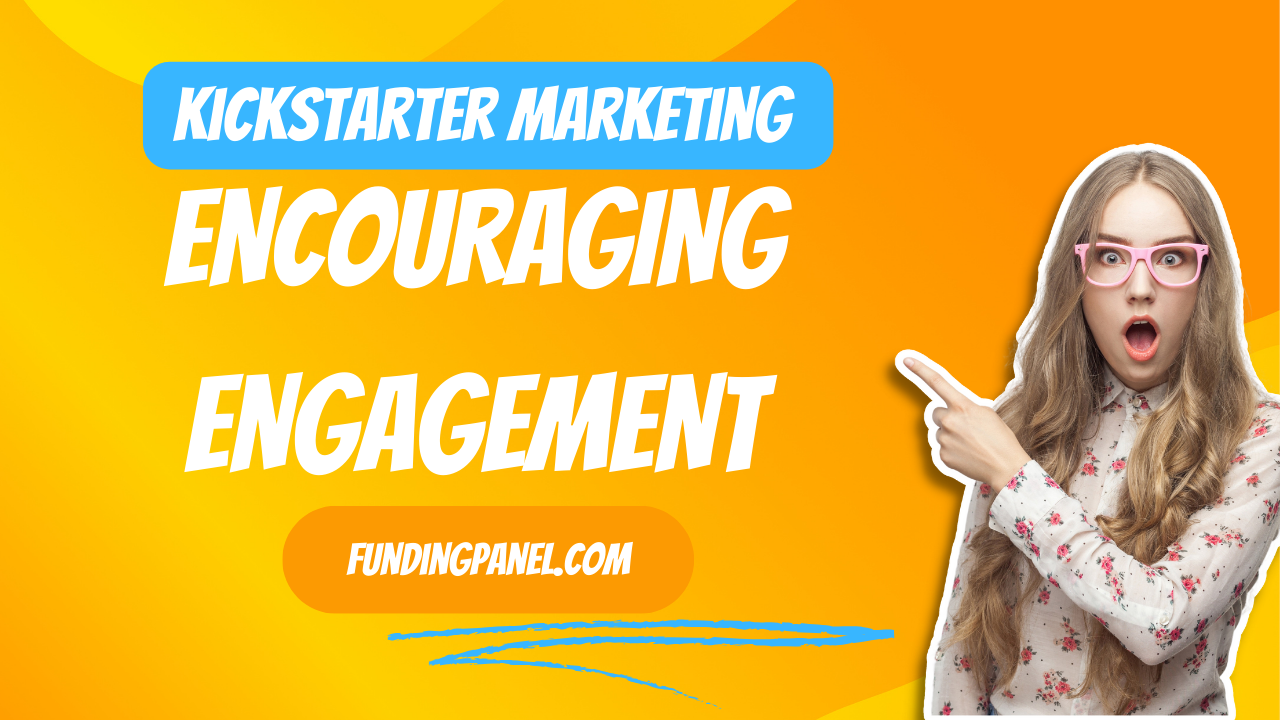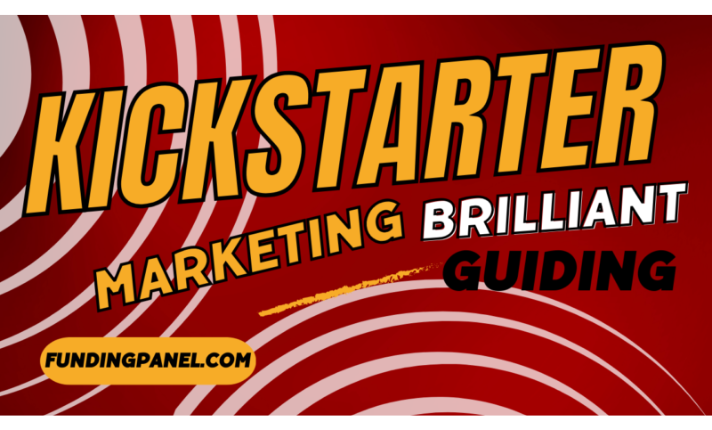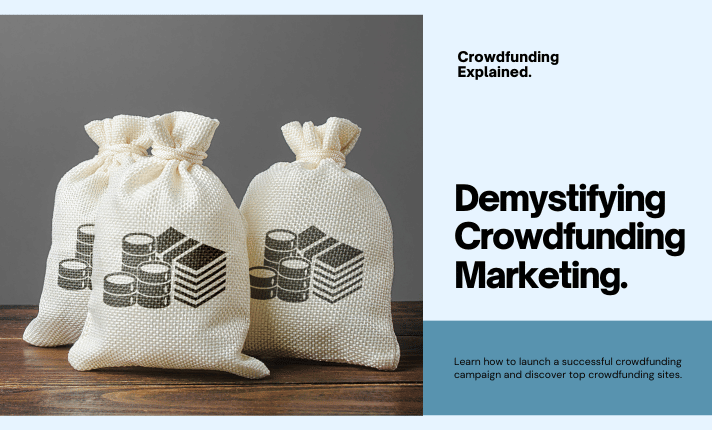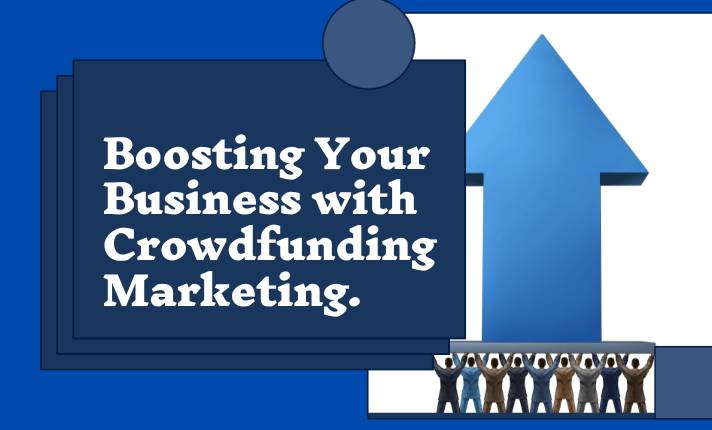Certainly! Understanding Kickstarter marketing is crucial for successfully launching and funding a project on the crowdfunding platform. Here are key components to consider:
Kickstarter marketing Pre-launch Preparation:
- Build a Solid Foundation: Before launching your campaign, ensure your project is well-defined and you have a prototype or clear concept to showcase.
- Create a Compelling Story: Craft a compelling narrative explaining who you are, your project, and why people should support it. Use engaging visuals, videos, and storytelling to connect with potential backers emotionally.
Kickstarter marketing Social Media Presence:
- Build a Community: Start building a community around your project on social media platforms well before the launch. Engage with potential backers, answer questions, and generate interest.
- Teasers and Previews: Release teasers, behind-the-scenes content, and previews to generate curiosity and anticipation.
Kickstarter marketing Email Marketing:
- Build an Email List: Collect email addresses of interested individuals before the launch. Use platforms like Mailchimp or similar tools to manage and send updates.
- Launch Notifications: Send out launch notifications to your email list on the day of the campaign. These initial backers can help create momentum.
Kickstarter marketing Press Outreach:
- Create a Press Kit: Prepare a press kit with high-quality images, press releases, and other relevant information. Contact relevant media outlets, bloggers, and influencers in your niche.
- Media Coverage: Securing media coverage can significantly boost your project’s visibility.
Kickstarter marketing Page Optimization:
- Compelling Title and Description: Craft a catchy and informative title. Write a detailed yet concise project description highlighting key features and benefits.
- High-Quality Visuals: Use high-quality images and videos to showcase your product or project. Visuals are crucial for capturing attention.
Kickstarter marketing Reward Tiers and Stretch Goals:
- Strategic Reward Tiers: Offer a variety of reward tiers at different price points to attract a broader range of backers.
- Stretch Goals: Consider incorporating stretch goals to incentivize backers to share and promote your campaign to unlock additional features or perks.
Regular Updates:
- Keep Backers Informed: Regularly update your backers on the campaign’s progress, milestones, and any changes. This helps build trust and keeps backers engaged.
Post-Campaign Engagement:
- Fulfillment Plan: A clear plan for fulfilling rewards, including production, shipping, and potential challenges.
- Maintain Communication: Continue to communicate with backers even after the campaign ends. Keep them informed about the production process and any delays.
Paid Advertising:
- Targeted Ads: Use targeted online advertising on platforms like Facebook or Instagram to reach potential backers.
- Budget Planning: Allocate a budget for advertising but ensure it aligns with the potential return on investment.
Analytics and Adjustments:
- Monitor Campaign Analytics: Keep a close eye on your campaign’s analytics to understand what is working and needs adjustment.
- Adapt and Optimize: Be ready to adapt your marketing strategy based on the campaign’s performance.
Remember that each campaign is unique, and there is no one-size-fits-all approach. Tailor your marketing strategy to your project, audience, and resources.
The Role of a Kickstarter Marketing Agency
A Kickstarter marketing agency is pivotal in helping creators launch and promote their crowdfunding campaigns on the Kickstarter platform. Here are the critical aspects of the role of a Kickstarter marketing agency:
Kickstarter marketing Campaign Strategy and Planning:
- Target Audience Identification: The agency helps identify and define the target audience for the project, ensuring that marketing efforts are directed towards the most relevant potential backers.
- Campaign Timeline: They assist in planning the campaign timeline, including pre-launch activities, the duration of the campaign, and post-campaign fulfilment.
Pre-launch Preparation:
- Campaign Optimization: The agency helps optimize the Kickstarter campaign page, ensuring that it is visually appealing, has compelling content, and is structured to maximize conversion rates.
- Market Research: Conducting market research to understand the competitive landscape and position the project effectively.
Marketing Collateral Creation:
- Content Development: The agency assists in creating high-quality content for the campaign, including videos, images, and written materials. This may involve scriptwriting, video production, and graphic design.
- Copywriting: Crafting compelling and persuasive copy for the campaign page and marketing materials.
Social Media Management:
- Community Building: The agency helps build and manage a community on social media platforms, engaging with potential backers and creating buzz around the project.
- Content Calendar: Planning and executing a content calendar to maintain a consistent and engaging presence on social media.
Email Marketing:
- List Building: Assisting in creating and growing an email list by implementing strategies to capture leads and potential backers.
- Email Campaigns: Designing and executing effective email campaigns to keep potential backers informed and engaged.
Crafting a Killer Kickstarter Marketing Strategy
Crafting a killer Kickstarter marketing strategy is essential for capturing the attention of potential backers and ensuring the success of your crowdfunding campaign. Here’s a step-by-step guide to help you create an effective Kickstarter marketing strategy:
Understand Your Audience:
- Define Your Target Audience: Identify your ideal backers’ demographics, interests, and behaviors. Tailor your messaging and marketing channels to resonate with this audience.
Build a Pre-launch Buzz:
- Social Media Teasers: Create teaser content on social media platforms to generate curiosity and anticipation. Utilize visuals, behind-the-scenes content, and engaging captions.
- Email List Building: Implement strategies to build an email list of potential backers. Offer incentives such as exclusive updates, early access, or special discounts.
Optimize Your Kickstarter Page:
- Compelling Project Title: Craft a catchy and descriptive project title that immediately communicates the essence of your project.
- High-Quality Visuals: Use professional images and videos to showcase your product or project. Visuals are crucial for capturing attention.
- Clear and Concise Copy: Write a clear and compelling project description. Communicate the problem your project solves and why it matters.
Create an Engaging Video:
- Tell Your Story: Craft a compelling video about your project’s story. Please include information about yourself, your problem, and how your project solves it.
- Showcase the Product: Demonstrate the features and benefits of your product. Make sure the video is visually appealing and maintains viewer interest.
Dive Deeper: Kickstart Search Engine Marketing
Kickstarter Search Engine Marketing (SEM) involves leveraging paid advertising on search engines to increase the visibility of your crowdfunding campaign. Here’s a deeper dive into the critical aspects of Kickstart SEM:
Google Ads Campaign:
- Keyword Research: Conduct thorough keyword research to identify relevant terms that potential backers might use to search for projects similar to yours.
- Ad Copy Optimization: Craft compelling ad copy that includes relevant keywords and highlights the unique selling points of your project.
- Targeting Options: Use Google Ads’ targeting options to reach specific demographics, locations, and interests.
Bing Ads:
- Diversify Platforms: Consider running ads on Bing in addition to Google to expand your reach. Bing has a different user base, and your target audience may be active on both platforms.
- Campaign Customization: Tailor your campaigns on Bing to account for user behavior and demographic differences compared to Google.
Ad Budget Allocation:
- Strategic Budgeting: Allocate your SEM budget strategically, considering the duration of your campaign and the specific goals of your advertising efforts.
- Daily and Lifetime Budgets: Set daily and lifetime budgets to control spending and monitor the performance of your ads.
Conversion Tracking:
- Implement Tracking Codes: Install conversion tracking codes on your Kickstarter page to measure the effectiveness of your SEM campaigns.
- Attribution Modeling: Understand the customer journey and attribute conversions to the appropriate touchpoints in your advertising strategy.
Ad Extensions:
- Enhance Ad Visibility: Use ad extensions to provide additional information about your project, such as links to specific sections of your Kickstarter page, additional images, or direct communication methods.
- Sitelink Extensions: Direct users to specific pages on your Kickstarter project with sitelink extensions.
Remarketing Campaigns:
- Target Previous Visitors: Implement remarketing campaigns to target users who have visited your Kickstarter page but haven’t backed the project.
- Tailored Messaging: Craft specific ad messaging for users already engaged with your campaign.
Choosing the Right Kickstarter Marketing Firm
Choosing the right Kickstarter marketing firm is a crucial decision that can significantly impact the success of your crowdfunding campaign. Here are vital considerations to help you make an informed choice:
Experience and Expertise:
- Crowdfunding Experience: Look for a firm with a proven track record in crowdfunding, particularly with Kickstarter campaigns. Experience in your specific industry or niche is a plus.
- Digital Marketing Expertise: Ensure the firm has expertise in various digital marketing channels, including social media, email marketing, search engine marketing, and influencer outreach.
Portfolio and Case Studies:
- Review Past Campaigns: Examine the firm’s portfolio and case studies of previous Kickstarter campaigns they have worked on. Look for success stories, the range of projects, and the impact of their marketing efforts.
Client Testimonials:
- Seek References: Request references or testimonials from previous clients. Reach out to these clients to gain insights into their experiences working with the firm and the outcomes achieved.
Understanding of Your Project:
- Tailored Approach: Ensure that the firm takes the time to understand the unique aspects of your project. A one-size-fits-all approach may not be practical for diverse projects.
Clear Communication:
- Communication Style: Choose a firm that communicates clearly and transparently. Effective communication is vital for collaboration and understanding the progress of your campaign.
Services Offered:
- Full-Service Capabilities: Consider whether the firm offers a comprehensive set of services, including campaign strategy, content creation, social media management, press outreach, and paid advertising.
- Customization: Look for a firm that can tailor their services to your needs and budget.
The Power of Storytelling in Your Campaign
The power of storytelling is immense when it comes to running a successful crowdfunding campaign, especially on platforms like Kickstarter. Here’s why storytelling is crucial and how you can harness its potential in your campaign:
- Emotional Connection:
- Why it Matters: Storytelling allows you to create a personal and emotional connection with your audience. People are more likely to support a project when they relate to its story.
- How to Harness It: Share the story behind your project — what inspired it, the challenges you’ve overcome, and the passion driving your endeavor. Connect with your audience on a human level.
Engagement and Attention:
- Why it Matters: In a crowded online space, storytelling captures attention and keeps people engaged. It distinguishes your project from others and makes it memorable.
- How to Harness It: Craft a narrative that unfolds on your Kickstarter page, in your video, and across your marketing materials. Use compelling visuals and a well-structured storyline to keep backers intrigued.
Showcasing the Problem and Solution:
- Why it Matters: Storytelling allows you to effectively convey the problem your project solves and the solution it provides.
- How to Harness It: Clearly articulate your target audience’s pain points or challenges. Illustrate how your project addresses these issues, making it a solution worth supporting.
Building Trust:
- Why it Matters: Backers want to trust that their support will lead to a successful project. Storytelling builds trust by offering transparency and authenticity.
- How to Harness It: Share your journey, including both successes and challenges. Be open about the development process and showcase the team behind the project. Authenticity fosters trust.
Kickstarter marketing Creating a Narrative Arc:
- Why it Matters: A well-constructed narrative arc keeps backers engaged from the beginning to the end of your campaign.
- How to Harness It: Develop a storyline that has a clear beginning, middle, and end. Please start with the inspiration behind your project, build tension by highlighting challenges, and resolve them with the promise of a successful outcome.
Showcasing Impact:
- Why it Matters: Backers want to know their support will make a difference. Storytelling allows you to illustrate the impact your project will have.
- How to Harness It: Share stories of how your project positively affects individuals or communities. Use testimonials or case studies to demonstrate the real-world impact of your work.
Kickstarter marketing Encouraging Engagement:

- Why it Matters: Engaged backers are more likely to share your campaign and become advocates for your project.
- How to Harness It: Encourage backers to share their stories about your project. Create opportunities for interaction, such as Q&A sessions, polls, or contests. Foster a sense of community around your campaign.
Consistency Across Platforms:
- Why it Matters: Consistency in storytelling strengthens your brand and message, creating a cohesive and memorable experience for backers.
- How to Harness It: Ensure that your narrative is consistent across your Kickstarter page, social media posts, emails, and any other marketing channels. Use a unified voice and visual style.
Kickstarter marketing Call to Action:
- Why it Matters: A compelling story sets the stage for a solid call to action, inspiring backers to support your project.
- How to Harness It: Communicate what you need from backers and why their support is crucial. Use your story to motivate action and make it easy for backers to contribute.
In essence, storytelling is the thread that weaves your project into the fabric of your backers’ lives. It transforms your campaign from a transactional exchange to a shared experience, making backers feel like active participants in your journey. By harnessing the power of storytelling, you increase your chances of funding success and create a lasting connection with your audience.
Building Buzz: Social Media and Kickstarter
Building buzz on social media is a crucial component of a successful Kickstarter campaign. Social media platforms offer an excellent way to connect with your audience, generate interest, and drive traffic to your crowdfunding campaign. Here’s a guide on how to effectively build buzz using social media for your Kickstarter project:
Kickstarter marketing Choose the Right Platforms:
- Identify Your Audience: Understand your target audience and choose social media platforms where they are most active.
- Platform Selection: Popular choices include Facebook, Instagram, Twitter, and LinkedIn. Consider platforms that align with the nature of your project.
Create Compelling Profiles:
- Consistent Branding: Maintain consistent branding across all your social media profiles. Use the same profile picture, banners, and project visuals.
- Optimize Profiles: Ensure your profiles have a concise bio, a link to your Kickstarter campaign, and relevant contact information.
Kickstarter marketing Teasers and Sneak Peeks:
- Generate Anticipation: Share teaser content, sneak peeks, and behind-the-scenes looks at your project. Create a sense of anticipation leading up to your campaign launch.
- Visual Content: Use images, graphics, and short videos to make your content visually appealing and shareable.
Engage with Your Audience:
- Respond Promptly: Actively engage with your audience by responding promptly to comments, messages, and mentions.
- Ask Questions: Encourage interaction by asking questions related to your project. This boosts engagement and helps you understand your audience better.
Kickstarter marketing Build a Community:
- Create Groups or Pages: Consider creating dedicated groups or pages for your project. This fosters a sense of community among your backers.
- Encourage User-Generated Content: Encourage backers to share their thoughts, experiences, and content related to your project.
Content Calendar:
- Plan Regular Posts: Develop a content calendar outlining the frequency and type of posts you’ll share. Maintain a consistent posting schedule to keep your audience engaged.
- Diversify Content: Include a mix of project updates, personal stories, and relevant content to keep your feed interesting.
Analytics and Optimization for Kickstarter Campaigns
Analytics and optimization play a crucial role in the success of a Kickstarter campaign. By continuously monitoring key metrics and making data-driven adjustments, you can enhance the effectiveness of your campaign. Here’s a guide on how to leverage analytics and optimize your Kickstarter campaign:
Analytics:
Kickstarter marketing Conversion Rates:
- Metric to Track: Monitor the conversion rate, representing the percentage of people visiting your Kickstarter page and becoming backers.
- Analysis: Identify trends and patterns in conversion rates. Analyze which traffic sources or campaign updates correlate with changes in conversion.
Kickstarter marketing Traffic Sources:
- Metric to Track: Analyze traffic sources and understand where your backers come from.
- Analysis: Identify the most effective channels driving traffic to your campaign, whether direct, social media, email, or external websites.
Kickstarter marketing Backer Demographics:
- Metric to Track: Collect and analyze demographic data about your backers, such as age, location, and interests.
- Analysis: Tailor your marketing strategies based on the demographics of your most engaged audience.
Kickstarter marketing Engagement Metrics:
- Metrics to Track: Monitor engagement metrics like the number of comments, likes, and shares on your Kickstarter page and social media platforms.
- Analysis: Assess the level of community engagement and adjust your content strategy accordingly.
Leveraging Influencers for Kickstarter Success
Leveraging influencers can significantly enhance the success of your Kickstarter campaign by expanding your reach, building credibility, and generating interest. Here’s a guide on how to effectively use influencers for Kickstarter success:
Identify Relevant Influencers:
- Alignment with Your Niche: Look for influencers whose audience aligns with your project’s target demographic and interests.
- Previous Kickstarter Collaborations: Consider influencers who have previously supported or collaborated on Kickstarter projects.
Build Relationships in Advance:
- Engagement: Start engaging with potential influencers before you launch your campaign. Follow them, comment on their content, and share relevant information.
- Direct Outreach: Reach out directly to express your admiration for their work and explain how your project aligns with their interests.
Provide Clear Information:
- Project Overview: Communicate the critical aspects of your project, such as its uniqueness, value, and potential impact.
- Campaign Details: Share information about your Kickstarter campaign, including launch date, funding goal, and critical milestones.
Customized Collaboration Proposals:
- Tailored Proposals: Craft personalized collaboration proposals for each influencer. Highlight how their involvement can benefit both parties.
- Collaboration Ideas: Propose collaboration ideas, such as sponsored content, exclusive behind-the-scenes access, or influencer-specific reward tiers.
Post-Campaign: Keeping the Momentum Alive
Post-campaign efforts are crucial for maintaining the momentum generated during your Kickstarter campaign and ensuring ongoing success. Here’s a guide on how to keep the momentum alive after your Kickstarter campaign:
Fulfillment Updates:
- Regular Communication: Keep backers informed about your project’s production and fulfillment progress.
- Transparency: Address delays or challenges transparently, building trust with your backers.
Exclusive Backer Content:
- Behind-the-Scenes Access: Provide exclusive behind-the-scenes content, updates, or sneak peeks to backers. Make them feel involved in the ongoing journey of your project.
- Backer-Only Surprises: Offer surprises or additional perks exclusively to backers to show appreciation for their support.
Engage on Social Media:
- Continued Updates: Maintain an active presence on social media with regular updates related to your project.
- User-Generated Content: Encourage backers to share their experiences and content related to your project, creating a sense of community.
Email Newsletters:
- Regular Newsletters: Send regular newsletters to your backers, summarizing recent progress, sharing news, and expressing gratitude.
- Future Plans: Tease plans, projects, or collaborations to keep backers excited about your brand.
Post-Campaign Marketing:
- Expand Reach: Continue marketing efforts post-campaign to reach a broader audience who may have missed the Kickstarter campaign.
- New Platforms: Explore additional platforms or avenues to showcase your project and attract new supporters.
Measuring Success: Key Performance Indicators
Measuring the success of your Kickstarter campaign involves tracking various key performance indicators (KPIs) that provide insights into different aspects of your project’s performance. Here are key metrics to monitor:
Funding Goal Achievement:
- Metric: Percentage of funding goal achieved.
- Significance: Indicates how close you are to reaching your target. The higher the percentage, the more successful your campaign is in terms of funding.
Backer Count:
- Metric: Total number of backers.
- Significance: Measures the size of your supporter base. More backers can indicate broad interest and support for your project.
Conversion Rate:
- Metric: Percentage of people who visited your Kickstarter page and became backers.
- Significance: Reflects the effectiveness of your campaign in turning visitors into backers. A higher conversion rate indicates a compelling campaign.
Average Pledge Amount:
- Metric: Average amount pledged per backer.
- Significance: Helps you understand the value each backer contributes on average. Increasing the average pledge can boost overall funding.
Traffic Sources:
- Metric: Where your backers are coming from (e.g., direct, social media, email).
- Significance: Identify the most effective channels for driving traffic to your campaign. Focus on optimizing high-performing sources.
Final Thoughts.
In conclusion, a successful Kickstarter campaign requires a strategic and multifaceted approach encompassing pre-launch preparations, effective marketing, engaging with backers, and post-campaign efforts. Here are some key points to remember:
Frequently Asked Questions
Q1: What is Kickstarter?
A: Kickstarter is a crowdfunding platform where creators can launch campaigns to fund creative projects. Backers pledge money to support projects; in return, creators offer rewards based on the level of support.
Q2: How does Kickstarter work?
A: Creators launch campaigns with a funding goal and a set duration. Backers contribute money to help reach the goal. If the goal is met by the campaign’s end, backers’ pledges are collected, and rewards are distributed. If the goal isn’t met, no funds are collected.
Q3: What types of projects are allowed on Kickstarter?
A: Kickstarter supports various creative projects, including art, technology, film, music, games, design, and more. However, it doesn’t support causes, charities, or projects for financial gain.
Q4: How do I create a successful Kickstarter campaign?
A: Plan thoroughly, create a compelling project page, set realistic goals, engage your audience through marketing and social media, and provide regular updates. Learn from successful campaigns and adapt your strategy based on analytics.
Q5: What are Kickstarter rewards?
A: Rewards are items or experiences offered to backers based on their pledge amount. Depending on the project, they can include the final product, exclusive merchandise, early access, or personalized experiences.











